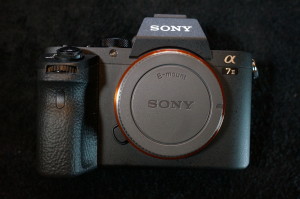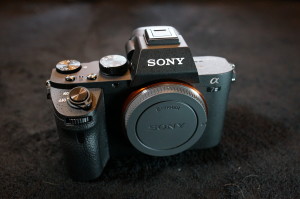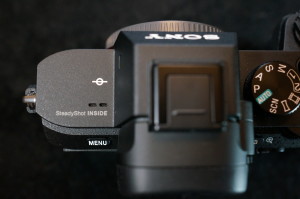Sony is first and foremost a technology company, and they are doing things with the A7 series that are currently unequaled. This camera is unique in the marketplace. As of this writing, there’s literally nothing else like it from Sony’s direct competitors (Nikon, Canon, Panasonic, Olympus, Fuji, Pentax). If you want a full frame mirrorless cam (and don’t want to trade your car for a Leica), you’re getting an A7. The only question is which A7.
Read more A7ii reviews on Amazon.
The original A7 was named “camera of the year” for cramming a 24MP full frame sensor into a compact mirrorless body. How does Sony top it with the A7ii? By improving ergonomics, focus speed, video capabilities, and delivering a groundbreaking IN BODY image stabilization system – the world’s first 5-Axis stabilized full frame sensor. This illustrates a couple of admirable characteristics about Sony’s imaging division – they listen to customers, and they relentlessly innovate. When Sony updates a camera (which they do often), they deliver significant design changes that translate to real world improvement – not just megapixel boosts.
A note about lenses: the lens situation is improving. At Photokina Sony announced a number of new E-mount lenses that are expected to hit the market in the coming year. At the time of this writing, the best native prime lenses for the A7ii are the brilliant Zeiss 55 f1.8 and the Zeiss 35. I’ve heard the Zeiss 16-35 is outstanding but have not tried it yet. Of course with an inexpensive adapter, you can use just about any lens you please with an A7, and that’s what makes these cameras so wonderful.
We bought our A7ii on Amazon and got it the first day of release. In this review, we’re going to assume you know the basics about the A7 series, and go straight to the pros and cons of the new camera.
WHAT’S GOOD
*In Body Steadyshot – This is the marquee feature and for good reason. Now ALL of your lenses have image stabilization – including those 40-year old Nikkors and Leicas. It’s amazing and it works. Of course the stabilization is more helpful with lenses towards the telephoto end of the spectrum. I’ve tried it with my 105mm and 300mm Nikkor primes with impressive results. With native E-mount lenses that deliver focus distance information, you get full 5-Axis stabilization. If there’s no electronic communication with the camera to transmit focus distance (as with older legacy lenses) you get 3-Axis stabilization. Note that for legacy lenses, you’ll want to manually specify the focal length to ensure the best results. And yes, Steadyshot works a treat for handheld video too.
*Shutter release – The shutter release has been moved forward on the camera body to a more natural location. It’s now right where your finger expects it to be.
*Better Grip – The new hand grip is thicker and easier for my hand to grasp. The new grip extends about 10mm further from the body.
*Improved Autofocus – Sony is claiming 30% better autofocus performance. While many were hoping for AF as fast as the a6000, it’s not there yet. But Sony has improved the focusing algorithms to elicit noticeably better performance.
*Build quality – More magnesium is now used in the camera body, and it’s obvious. The camera feels solid and reassuring in the hands, like it’s been carved out of metal. Even the buttons and control dials add to the premium feel of the camera.
*Video – The A7ii has several notable video improvements. High quality 50 Mbps XAVC S codec is now included. Built in stabilization is a huge help with nonstabilized lenses. And the camera includes a S-LOG picture profile with enhanced dynamic range that’s useful for color grading.
*Wifi – This is not a new feature, but Sony has done a nice job integrating wifi into the camera. The wifi features really showcase Sony’s prowess as a tech company (Nikon and Canon have badly lagged behind in this department, IMHO). We are already taking this stuff for granted, but it’s really kind of incredible to remotely control your camera from your tablet or phone. If you want to share photos from your full frame camera to social media, it’s been made easy for you, no clunky adapters required.
*Alpha menus – Sony has now standardized the Alpha menu system across several different camera bodies. It’s a clean, logical user interface that works well. The upshot? You spend less time “menu diving” and more time taking photos.
*EVF – The A7ii electronic viewfinder is essentially the same as the A7, but it should be noted that it’s great. The EVF is what allows Sony to squeeze down the body size of the A7 series. Once you get used to having focus assist and peaking (and the results of your shot) available inside the EVF, you will love it. What once seemed like a drawback of mirrorless cameras is now a huge advantage.
*Metal lens mount – The A7ii lens mount is more robust than that of the first gen cameras. No wiggle! Lenses mount nice and tight to the body.
*Startup time – Startup time of the camera has been improved, which means fewer missed shots.
*Matte finish – This is a matter of taste, but I like the matte finish of the A7ii.
*Apps – The PlayMemories apps store has a few worthwhile apps like time lapse. It would be nice if Sony built some of these features into the camera, but they are inexpensive and an app purchase can be installed on up to 10 cameras. Sony needs to open the app store to outside developers to make the most of this functionality.
WHAT’S NOT SO GOOD
*Weight – Weight has increased over the original A7 by 146 grams or 5.15 ounces to 599 grams. This is no small increase (a 26% gain over the A7, to be precise). When packing camera gear, every ounce matters. If it gets much heavier, we’re losing a key advantage of mirrorless. Yet to be fair, at 599 grams the A7ii is still lighter than the Nikon Df (760g), Canon 6D (760g), Canon 5D Mark III (950g) and Nikon D800 (980g). Of course none of those competing cameras offer in body image stabilization. So the A7ii remains lighter than the competition while offering a uniquely powerful functionality. If the added weight is a deal killer for you, there’s always the original A7.
*Thickness – The A7ii body is not quite as svelte as the original A7. Thickness of the body itself has increased by a couple of mm. It seems more pronounced because the new grip extends a good 10mm further than the old. The A7ii is (dare I say it?) a bit chunky. The body has become more like a blend of mirrorless and DSLR. I suspect that the average non-photographer would glance at this camera and assume it is a DSLR.
*No 4k video – Not a major omission to me, but it will be for some. If you must have 4k, you want the A7S.
*No silent shutter – The shutter noise is improved over the original A7, but it’s not the dead silent shutter of the A7S.
*Antialiasing filter – The A7ii has a low pass filter. I’d prefer they omit it.
*No battery charger – Battery life is not a strength of these cameras (rated at 350 shots per charge) so you will want extra batteries. If you want an external battery charger, you’ve got to buy your own. I have several batteries and prefer to charge the extras while still having my camera free to use.
WRAP IT UP (WE’LL TAKE IT!)
Whether you want an A7ii really boils down to two words : STEADYSHOT INSIDE. With the A7ii, it’s all about image stabilization. That’s why you pay the premium for this camera over a first generation body. If you shoot with lenses that lack OSS (and that includes all legacy lenses) then it makes sense to get the A7ii. It’s like getting a nice across-the-board upgrade to your lens collection. I have a host of Nikkors and some unstabilized E-mount that will benefit.
Of course the ergonomic improvements of the A7ii are welcome. I’m sure that many professionals will upgrade to the A7ii simply for the relocated shutter release button and improved grip.
The 24MP sensor of the A7ii is basically the same as that used in the A7. If you want a high resolution mirrorless monster, you want the Sony A7R.
If you are heavily interested in VIDEO, your decision may come down to the A7ii versus the A7S. Consider it this way: the A7S is a video camera that takes stills, while the A7ii is a stills camera that takes great video. While “steadyshot inside” certainly helps with handheld shooting of video on the A7ii, lowlight performance trails the A7S. If you must have the King of Lowlight Video, you still want the A7S.
Because I shoot both video and stills I debated between the A7ii and the A7S (you can read about the A7S on Amazon). It was a difficult choice, but I ultimately decided that the superlative all around performance of the A7ii was best for me.
I have owned (and in some cases still own) cameras from Nikon, Canon, Panasonic, Fuji, and Olympus. At the moment there’s literally not an apples-for-apples competitor to this Sony camera. (If you really want a Nikon, you might consider the Nikon D750 – that’s a very different camera, though.) I buy the camera that is the best for my needs and am not loyal to one brand. Lately it seems that SONY is the company that’s delivering innovation and excitement in this space. While Nikon and Canon have gingerly tested the waters of mirrorless camera design (no doubt to protect their existing DSLR product lines), Sony has been fearlessly pushing ahead with groundbreaking technology. Sony makes the sensors, and is on a quest for market share; we photographers are reaping the benefits.
Today, we find the A7ii the best general purpose full frame camera on the market. It’s compact, solidly built but not too heavy, plays nice with a huge number of lenses, and is packed full of AMAZING technology. It just does everything (stills and video) very well. And by the way, the price is quite reasonable considering all it delivers. It’s one of the most affordable full frame cameras you can buy. If you buy one, we think you will enjoy it.




